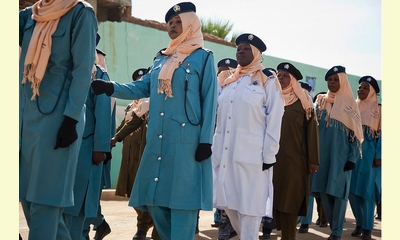|
|
Why UN Peacekeeping Falls Far Short of Female Soldiers
un article par Barbara Crossette, Pass Blue (abridged)
Since Security Council resolutions began demanding
more significant attention to roles for women in
conflict areas and the peace-building that
follows, much of the discussion has justifiably
centered on protection of civilians, because women
and their children suffer most in war and
dislocation. Less attention has been paid to the
woeful numbers of women in uniform fielded by
United Nations peacekeeping missions. The two
subjects are not unrelated. Women in uniform can
be a potent symbol and solace to those who quickly
become the innocent casualties of war.

Sudanese police women, part of a network sponsored by the UN's peacekeeping mission in North Darfur. Fewer than 4 percent of UN peacekeepers worldwide are women soldiers or police. SOJOUD ELGARRAI/UNAMID
click on photo to enlarge
Yet fewer than 4 percent of UN peacekeepers
globally are women in uniform, as soldiers or
police, says a new report, “Not Just a Numbers
Game: Increasing Women’s Participation in UN
Peacekeeping,” published in July by the
International Peace Institute in New York, a
nongovernmental organization with close ties to
the UN. The study, by Sahana Dharmapuri, an
independent gender adviser and trainer, turned a
glaring spotlight on the thin ranks of women. It
concluded that both troop-contributing countries
and UN peacekeeping officials share the blame for
the shortfall of women and the responsibility to
correct the imbalance. The outlook is not sunny.
“The UN is unlikely to reach its goals for gender
equality in peacekeeping missions because it is
not fully implementing its own two-pronged
approach: increase the number of women in
peacekeeping operations and integrate a gender
perspective within these missions,” Dharmapuri
wrote.
Three problems that are familiar to those who
follow issues in the field of women, peace and
security have created and sustained the situation,
Dharmapuri said in her report. First, member
states show “a lack of understanding” — a kind way
to put it — of the groundbreaking Security Council
resolution, 1325, and UN policies toward gender
equality. Second, there is “a gap in data and
analysis about women’s participation in national
security institutions globally and in UN
peacekeeping in particular.” Third and most
important, the author wrote, is “the prevalence of
social norms and biases that perpetuate gender
inequality within the security sector.” . . .
Dharmapuri makes five concrete recommendations that
include more research and coaching in UN member
nations.
Why press this issue, and why now? Dharmapuri has
this to say: “Lessons learned from NATO, the UN,
and member states show that information gathering
and analysis is improved when the differential
impact of armed conflict on women and men is taken
into account. Attention to both men’s and women’s
distinct experiences in conflicts reveals
comprehensive information on the area of
operation, including the identities of local power
brokers; division of labor; access to resources;
kinship and patronage networks; and community
security threats, risks, interests and needs. Such
thorough information gathering about the impact of
a peacekeeping operation on the local population —
men and women — can increase the capacity of the
mission to effectively accomplish its goals."
|








|
DISCUSSION
Question(s) liée(s) à cet article:
UN Resolution 1325, does it make a difference?,
* * * * *
Commentaire le plus récent:
A recent study by the NGO Working Group on Women, Peace and Security is critical of the UN Security Council for its inconsistent implement of Resolution 1325 that calls for an increased role of women in peacekeeping and peacebuilding. The full report is available on the Internet on the website of womenpeacesecurity.org.
The working group members are an impressive group of active international NGOs: Amnesty International; Consortium on Gender, Security and Human Rights; Femmes Africa Solidarité; Global Action to Prevent War; Global Justice Center; Human Rights Watch; The Institute for Inclusive Security; International Action Network on Small Arms; International Alert; International Rescue Committee; Refugees International; International Women’s Program of the Open Society Foundations; Social Science Research Council; Women’s Refugee Commission; Women’s Action for New Directions; Women’s International League for Peace and Freedom.
Here is the report's Summary of Findings
General trends in the Council over the last 12 years have shown significant development, including in the language and expertise on women, peace and security in resolutions, more expertise available to deploy in terms of gender advisors and women, peace and security, and a more sophisticated understanding of the key issues at the root of this agenda. There is a better understanding of, for example, what it takes to have disarmament, demobilization, and reintegration processes that are responsive to women; security sector reform that is responsive to women; and post-conflict elections that support women candidates and women voter. However, there is inconsistency in the Council’s deployment of that knowledge. There is still a significant disconnect between the content of reports received by the Council, meetings the Council holds, and resolutions it adopts.
There have been a number of positive developments in the Council’s use of women, peace and security-specific language in its policy over the last year. For the first time, for example, the Council used women, peace and security language in its resolution on Cyprus. However, there have also been inconsistencies. The Council’s initial lack of support for women in September 2011’s resolution on Libya was rectified by strong support in its March 2012 renewal. . ... continuation.

|
|









